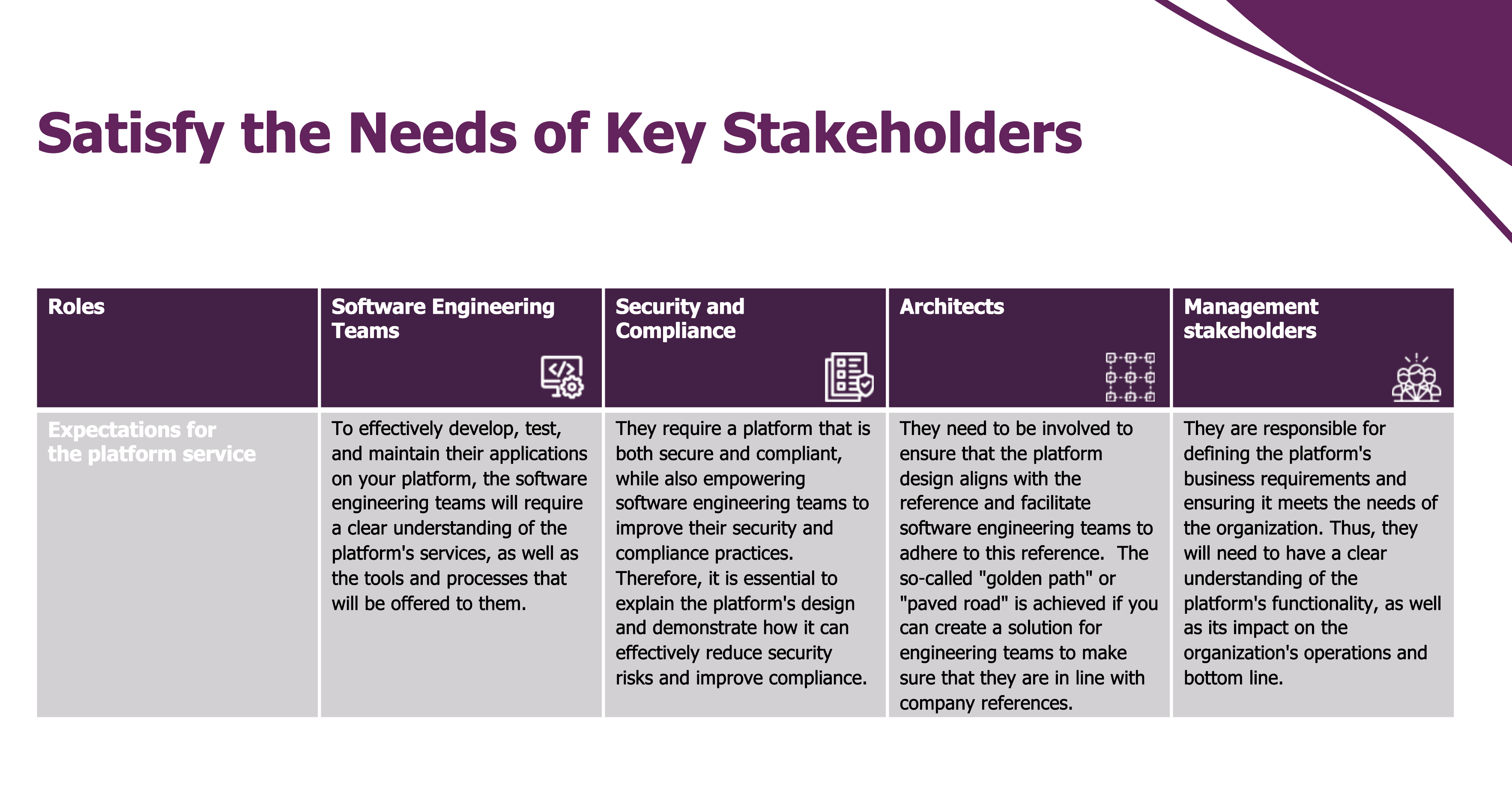Platform engineering has become an undeniable trend that requires no further emphasis. A robust internal platform service can work wonders for your software engineering teams by enabling them to deliver top-notch software solutions with speed, instead of grappling with infrastructure and tools.
However, Rome wasn't built in a day, and neither will your internal platform service. Finding the right direction to build a successful internal platform service is far more critical than sightless efforts. Fortunately, you are in luck today! Keep scrolling and discover the strategic steps you need to take to turn your internal platform service from vision to reality.
Step 1: Define the value of the platform service and align it with the organizational goals
The first step in launching an internal platform service is to define its value and align it with the organization's goals. As businesses embark on the digital transformation journey, they aim to boost delivery velocity, enhance the quality of digital products, and fortify system security. By ensuring that the platform service delivers value in achieving these objectives, it creates a harmonious synergy between platform engineering efforts and the digital transformation mission.
But how do we define the value of the platform service and align it with the organizational goals? It all starts by identifying the intended users and understanding their needs. The platform team must find what is valuable for both platform users and the organization. To achieve this, user personas can be created to figure out the target audience's needs, behaviours, and preferences. Another way is mapping the needs of the personas and the organization on a Value Proposition.
Once the value is clear, the next step is to form a coherent vision of the platform service and communicate this to the platform stakeholders. The vision acts as a northern star, directing the platform services to align with the company's overall strategy and maintain focus.
Step 2: Specify the scope of the platform service
To kickstart an internal platform service, the second crucial step is to specify its scope based on the value and intended users defined in step one. A fitting scope is important in the initial setup of any platform. Define a too broad scope and you will risk heavy investment in unproven initiatives and an underused platform offering. Define a scope too narrow and risk your users becoming frustrated with the burden of having to integrate your solution with other services.
Defining the scope often starts with mapping out a set of capabilities that the platform needs to offer. There are several dimensions to take into consideration when defining the set of capabilities:
-
Firstly, it is essential to identify the user journeys for the target user personas that were created. This helps to pinpoint the parts where the platform service can offer the most value to users. Secondly, by defining the capabilities required for each episode of the user journey, it becomes possible to develop services that provide value in every aspect. Thus, the platform service is built with precision and purpose, enabling it to deliver maximum value to users while minimizing the cost of maintenance and complexity.
-
Another crucial factor that determines the capabilities of your platform is the organizational context. It is important to identify the focal points for your services based on the specific needs of your organization. This might include areas such as infrastructure, CI/CD, observability, or data. Once you have decided on the type of platform required, the next step is to leverage a reference model to inventory the capabilities needed to offer those services.
Reference model: our reference model is inspired by the best practices in the industry and our extensive experience in guiding our clients towards successful platform initiatives. We use an outside-in perspective, focusing on the individuals and teams who will use the platform. Our assessment methodology covers 9 key categories and evaluates both the scope of the features delivered and the self-service nature of how they are delivered. With this reference model, you can identify opportunities to optimize your platform engineering initiatives.
Step 3: Identify and align with key stakeholders
To progress the development of the internal platform service, the next step is to identify the key stakeholders who will need to continuously be involved. The stakeholders who should be kept in the loop include your users (often software engineering teams), security & compliance, architects, and management (both business and IT). Since these stakeholders will have varying needs and expectations, it's essential to understand their responsibilities in the organization and their corresponding requests for the platform service to develop a service that caters to their needs.

By involving all relevant stakeholders in the platform service's development and implementation, you can ensure that the platform services deliver value for the entire organization.
Step 4: Develop the strategic roadmap
Once a strategic vision and goals have been established, the next step is to create a roadmap for the development and delivery of the platform service. The roadmap is a tangible embodiment of the focal points identified in the goals, and it also serves as a communication tool for all stakeholders.
This roadmap should outline the goals, timeline, milestones, and deliverables. The timeline can start with a simple “Now, Next, Later” structure, as long as it is clear to everybody what can be expected from you. As with any product, it is important to make sure that the roadmap considers not only the development of new capabilities but also operations and the work you will need to do to get the platform services adopted. User onboarding, Roadshows, demos and hackathons are all both valuable and time-consuming.
An indicator of a good roadmap is your stakeholders recognizing their wishes or a quick understanding of your reasoning behind prioritization choices.
Step 5: Set up the platform team and start delivering
It is now time to set up a top-notch platform engineering team that can effectively provide desirable platform services.
The platform team uses the platform vision to have a clear picture of the platform value and how the internal platform service aligns with the organizational goals. They should consistently strive to provide value to platform users and improve the platform based on user feedback.
To achieve this, the platform team can start by identifying the first group of representative platform users and onboarding them to the platform. Focusing on the first couple of users (teams) and building a relationship with them helps the platform service establish trust and a reliable feedback channel. Delivering value to your first users means that they can become advocates for the platform service, greatly enhancing platform adoption through “word-of-mouth" marketing and reducing potential resistance to yet-another-service.
However, the platform team must not merely prioritize users’ preferences, given that users often focus on short-term gains; they need to inspire users with more possibilities and have a strong vision to ensure the platform services stay aligned with the company's long-term goals. The platform team needs to maintain an entrepreneurial spirit and seek out what is next.
Conclusion:
While launching an internal platform service is not an easy feat, following these steps will enable you to go from zero to one. Are you eager to take your platform service from zero to hero? Keep an eye out for the upcoming articles where we will share tips on how to build a top-notch platform engineering team and scale your platform services.
Check out our Platform Engineering Service Page to delve deeper into the platform engineering field. If you're uncertain about the benefits that platform engineering can offer to your organization, our article Platform Engineering Unveiled, the Hidden Gems beyond the Hashtag is worth reading!





